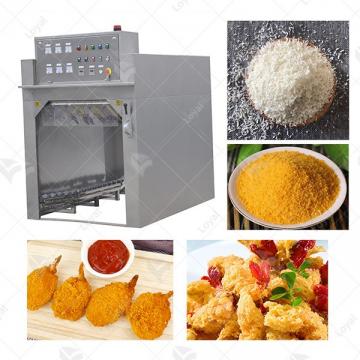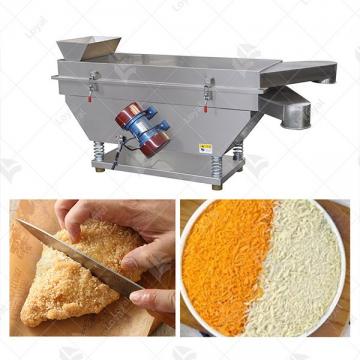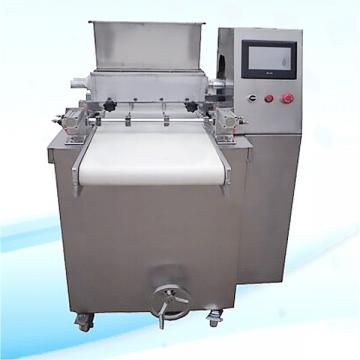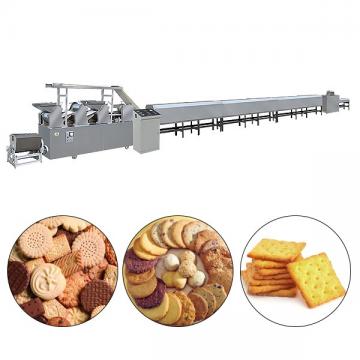
- Shandong Loyal Industrial Co.,Ltd.
- Macaroni Production Machine Instant Noodle Machine Biscuit Making Machine
Home> Processing> Biscuit Food Machinery: A Comprehensive Analysis of the Entire Production Process

Biscuit Food Machinery: A Comprehensive Analysis of the Entire Production Process
2025-05-06 10:27:12Biscuits, as a beloved type of snack, owe their production to advanced food machinery. From raw material processing to final packaging, a biscuit production line involves a wide range of complex and sophisticated equipment. This article delves into the various aspects of biscuit food machinery, including raw material handling, shaping, baking, cooling and sorting, and packaging, to reveal how these machines work together to produce high-quality biscuit products.

I. Raw Material Handling: The Foundation of Biscuit Quality
The primary raw materials for biscuits include flour, wheat powder, milk powder, butter, egg yolk powder, and more. The quality and processing of these raw materials directly affect the texture and quality of the biscuits. The first step in biscuit production is mixing flour with other ingredients. The dough mixer is the core equipment in this process, designed to blend flour with water or other liquids into a uniform dough. The mixer's body is typically made of stainless steel, which is not only durable but also easy to clean, meeting the hygiene standards of food production.
The design details of the dough mixer significantly impact biscuit quality. For example, the thickness and shape of the mixing blades affect the dough's texture. High-quality mixers use thicker mixing blades, which are not only less likely to deform but also ensure uniform dough mixing. Additionally, the mixing method varies depending on the type of biscuit. Shortbread biscuits require lower mixing intensity to maintain the dough's softness, while hard biscuits need higher mixing intensity for a more elastic dough. Some advanced dough mixers are equipped with safety control systems to prevent damage to the equipment and personnel due to improper operation.
In large-scale biscuit production, dough mixers often work in conjunction with other equipment. For example, a dough conveyor can transport the mixed dough to the next process. This automated workflow not only increases production efficiency but also reduces human intervention, lowering the risk of contamination. By precisely controlling the mixing time and intensity of the dough mixer, biscuit manufacturers can ensure the quality of each batch of dough, thereby laying a solid foundation for the subsequent shaping and baking processes.

II. Shaping Process: Defining the Appearance and Structure of Biscuits
The shaping process is a crucial step in biscuit production, determining the shape, size, and appearance of the biscuits. Shaping methods typically include stamping and cutting, with different methods suitable for different types of biscuits. For example, shortbread biscuits usually use stamping shaping, with mold patterns that are concave; while hard biscuits use cutting shaping, with mold patterns that are convex. This difference arises from the physical properties of the two types of biscuits: shortbread biscuits have a higher oil content and a softer texture, making them suitable for stamping; hard biscuits have a harder texture and are more suitable for cutting.
The biscuit shaping machine is the core equipment for achieving the shaping process. It not only processes the dough into various shapes of biscuits but also ensures uniform thickness of the biscuits. For example, hard biscuit shaping machines use food-grade PU conveyor belts, which have excellent wear resistance and flexibility, ensuring that the biscuits are not damaged during the shaping process. In addition, the design of the shaping machine also considers production efficiency and flexibility. Some shaping machines are equipped with replaceable molds that can quickly adjust the shape and pattern of the biscuits according to customer needs. For example, in the production of sandwich biscuits, the shaping machine can press two pieces of biscuits together and leave a space in the middle for the filling.
In addition to mold design, the rollers of the shaping machine are also important factors affecting biscuit quality. High-quality rollers are made of alloy materials with extremely high hardness, ensuring uniform thickness of the dough sheets during pressing and preventing breakage. At the same time, the design of the rollers also takes into account the flow of the dough. From the feed end to the discharge end, the diameter of the rollers gradually decreases. This design allows the dough to gradually thin out as it passes through the rollers, ultimately forming the ideal biscuit thickness. Moreover, the shaping machine is also equipped with a waste recycling device, which can recycle the excess dough generated during the shaping process, saving raw materials and reducing waste.

III. Baking Technology: Bestowing Unique Flavor and Texture on Biscuits
Baking is one of the most important steps in the biscuit production process, as it not only sets the shape of the biscuits but also imparts their unique flavor and texture. The oven is the core equipment for the baking process, and its performance directly affects the quality of the biscuits. Modern biscuit production lines typically use tunnel ovens, which feature multi-zone intelligent temperature control and can precisely control the baking temperature according to the type and thickness of the biscuits.
Ovens come in various heating methods, including electric, gas, and diesel. Each method has its own advantages and disadvantages. For example, electric ovens are easy to operate and have precise temperature control, but they have relatively high energy consumption. Gas and diesel ovens are more energy-efficient, but they require more complex combustion control systems. Some advanced ovens use ceramic infrared burners, which can produce uniform heat and allow biscuits to be baked evenly on both sides.
The internal design of the oven also has a significant impact on the baking effect. For example, the oven's mesh belt uses a herringbone weaving technique, which is resistant to corrosion and high temperatures and has a long service life. At the same time, the fine mesh holes of the herringbone belt provide good air permeability, ensuring that the biscuits are evenly heated during baking. In addition, the oven is equipped with an automatic pneumatic belt tracking device to prevent the belt from deviating during operation and extend its service life.
During the baking process, the moisture in the biscuits gradually evaporates, and the texture becomes more crispy. To ensure that the biscuits are not over-baked, the oven's temperature control system uses advanced PLC control technology. This control system can automatically adjust the temperature according to the baking status of the biscuits, ensuring that they are baked at the optimal temperature. At the same time, the oven's feed and discharge openings are equipped with flues that can promptly expel the steam generated during baking and prevent the biscuits from becoming damp.

IV. Cooling and Sorting: Ensuring the Stability of Biscuit Quality
After baking, the biscuits are at a high temperature and need to be cooled and sorted before entering the packaging stage. The cooling conveyor is a key piece of equipment in this process, designed to reduce the temperature of the biscuits to room temperature. Cooling conveyors typically use food-grade mesh belts or PU belts, which have good oil resistance and corrosion resistance, ensuring that the biscuits are not contaminated during the cooling process.
The design of the cooling conveyor also takes into account production efficiency and energy-saving effects. For example, some cooling conveyors use a multi-layer design to extend the cooling time within a limited space and improve cooling efficiency. At the same time, the edges of the cooling conveyor belt are neat and less likely to deviate, ensuring that the biscuits run smoothly during cooling. In addition, the cooling conveyor is equipped with an automatic cleaning device that can regularly clean the residual material on the belt and maintain the cleanliness and hygiene of the equipment.
During the cooling process, the texture of the biscuits gradually stabilizes. To ensure biscuit quality, the biscuit sorting machine plays an important role in this stage. The function of the biscuit sorting machine is to sort and arrange the cooled biscuits and remove substandard products. Workers can manually select biscuits on the sorting table, removing those with irregular shapes or defects to ensure that only high-quality biscuits enter the packaging stage. Through the cooling and sorting processes, the quality of the biscuits is further enhanced, laying the foundation for subsequent packaging.

V. Packaging Process: Ensuring the Freshness and Safe Transportation of Biscuits
Packaging is the final step in the biscuit production process and is crucial for ensuring the freshness and safe transportation of the biscuits. Modern biscuit production lines are equipped with a variety of packaging machines, including trayless packaging machines, sandwich packaging machines, and pillow packaging machines. These packaging machines can select appropriate packaging methods according to the type and shape of the biscuits, ensuring that the biscuits are not damaged during the packaging process.
Trayless packaging machines are suitable for packaging individual biscuits and can package biscuits directly in plastic film, saving packaging materials. Sandwich packaging machines are specifically designed for sandwich biscuits and can package two pieces of biscuits along with the filling, ensuring the integrity of the sandwich biscuits. Pillow packaging machines are suitable for packaging a variety of biscuits and can package biscuits in pillow-shaped bags, which are convenient for transportation and sales.
The degree of automation of packaging machines has a significant impact on production efficiency and packaging quality. Modern packaging machines typically use PLC control systems to achieve automatic packaging, sealing, and coding functions. This automated packaging method not only increases production efficiency but also reduces human intervention, lowering the risk of contamination. At the same time, packaging machines are also equipped with advanced detection devices that can automatically check the seal and integrity of the packaging bags to ensure the quality of each bag of biscuits.
The choice of packaging materials is also crucial for the freshness and safe transportation of biscuits. Modern packaging materials usually have a multi-layer composite structure with good moisture-proof, oxygen-proof, and odor-proof properties. For example, some packaging materials use aluminum foil composite layers that can effectively block external moisture and oxygen, extending the shelf life of biscuits. At the same time, packaging materials also meet food safety standards to ensure that biscuits are not contaminated during the packaging process.

VI The parameter of the biscuit line
|
Item No. |
Capacity(kg/h) |
Heating type |
|
LY-400 |
150-200kg/h |
Electricity,Gas,Diesel |
|
LY-600 |
400-500kg/h |
Electricity,Gas,Diesel |
|
LY-800 |
600-800kg/h |
Electricity,Gas,Diesel |
|
LY-1000 |
1000kg/h |
Electricity,Gas,Diesel |
|
LY-1200 |
2000kg/h |
Electricity,Gas,Diesel |
VII Conclusion
The continuous development of biscuit food machinery has brought higher efficiency and better quality to biscuit production. From raw material handling to shaping, baking, cooling and sorting, and packaging, each step relies on advanced equipment and technology. By optimizing the equipment and processes in these steps, biscuit manufacturers can produce more delicious, safe, and diverse biscuit products to meet consumer needs.
If you want to know more story about LOYAL brand, here can help you - https://www.facebook.com/foodmachineloyal
 Commercial Japanese Panko Bread Crumb Grinder Machine
Commercial Japanese Panko Bread Crumb Grinder Machine Japanese Bread Crumbs Processing Line
Japanese Bread Crumbs Processing Line Automatic Cookies Making Machines
Automatic Cookies Making Machines Fully Automatic Biscuit Making Machines
Fully Automatic Biscuit Making Machines